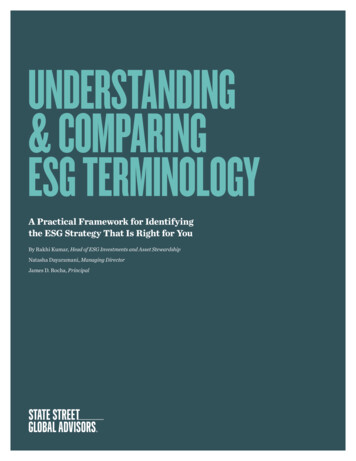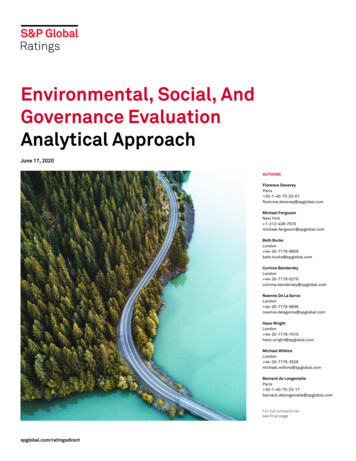
Transcription
Enterprise Strategy Group Getting to the bigger truth. ESG WHITE PAPERThe Application Security Testing ImperativeA Pragmatic Approach to Reducing Production Vulnerabilities with anIntegrated ApproachBy Doug Cahill, Vice President and Group DirectorNovember 2020This ESG White Paper was commissioned by Checkmarxand is distributed under license from ESG. 2020 by The Enterprise Strategy Group, Inc. All Rights Reserved.
White Paper: The Application Security Testing Imperative2ContentsExecutive Summary . 3Competing Objectives of the Application Economy . 3The Implications of Deadline-driven Decisions . 3The Open Source Software Dilemma . 4Demystifying DevSecOps . 5The Stages of a Shift-left Approach. 6The Planning Stage . 6The Development Stage . 6The Integration Stage . 7All Are Equally Important . 7Workflow Integration . 7Critical Success Factors for an Effective AST Program . 7Requirements for an Integrated Approach to AST . 8Code Analysis . 8Inspecting Source Code with Static Application Security Testing (SAST) . 8Spotlight: The Case for Interactive Application Security Testing (IAST) . 9IDE Integrated Developer Security and Awareness Training . 9Software Composition Analysis . 10Toolchain Integrations . 11Comprehensive Coverage of Programming Languages . 11The Bigger Truth . 11 2020 by The Enterprise Strategy Group, Inc. All Rights Reserved.
White Paper: The Application Security Testing Imperative3Executive SummaryThe central role of applications is such that they represent business-critical infrastructure and thus a prominent feature ofevery company’s attack surface. For organizations that build and deploy internally developed applications, the acceleratedrate of innovation has challenged cybersecurity objectives, creating an application security testing (AST) imperative.An integrated approach to applicationsecurity testing supports seemingly mutuallyexclusive objectives: agile softwaredevelopment and risk mitigation.Fortunately, foundational best practices employed toprotect production runtime environments apply to theimplementation of an AST program, principally,reducing attack surface and remediating exploitablevulnerabilities. An integrated approach to applicationsecurity testing supports seemingly mutually exclusiveobjectives: agile software development and risk mitigation.This paper provides practical guidance for CISOs, CIOs, and DevOps leaders for designing an effective application securityprogram to secure modern application development via an integrated approach. The paper also aims to equip applicationsecurity practitioners with research data to support building the business case for AST investments.Competing Objectives of the Application EconomyThe transformation to the digital enterprise has resulted in business applications serving critical front, middle, and backoffice functions. In addition to underpinning business operations, applications are often a primary point of competitivedifferentiation, creating pressure on internal application development teams to accelerate the rate at which new code isdeveloped and new builds are deployed to production. In fact, many organizations with a cloud-first orientation push toproduction multiple times per day.While the application stack comprises a heterogenous mix of technologies, cloud-native applications based on amicroservices architecture have accelerated rapid application development initiatives, fueling innovation. Modernmethodologies are also being brought to bear against the need for speed. Agile software development and the continuousintegration and continuous delivery (CI/CD) processes of DevOps have enabled an iterative approach to applicationdefinition and delivery.In contrast to managing risk in the context of the more deliberative approach of waterfall, in which phases and gates serveas checkpoints, the constant rate of change in today’s software development (SDLC) paradigm often creates a securityreadiness gap.The Implications of Deadline-driven DecisionsBut just how commonly do the pressures on application development project teams to move fast result in securityimplications? In research conducted by ESG, 79% of respondents shared their organizations regularly or occasionally pushcode to production with known organic vulnerabilities.1These teams are clearly feeling pressure to knowingly deploy vulnerable code, with 54% citing the need to meet a criticaldeadline with a plan to remediate the issue in a later release as the reason to deploy with known issues. The timing ofSource: ESG Master Survey Results, Modern Application Development Security, to be published. All ESG research references and charts in this whitepaper have been taken from the master survey results, unless otherwise noted.1 2020 by The Enterprise Strategy Group, Inc. All Rights Reserved.
White Paper: The Application Security Testing Imperative4discovery was also cited as a factor for deploying faulty code, with 45% noting that the issues were detected too late intheir cycle for them to be resolved (see Figure 1).Figure 1. Reasons for Pushing Code to Production with Known Organic VulnerabilitiesFor which of the following reasons has your organization pushed code to productionwith known organic vulnerabilities? (Percent of respondents, N 323, multipleresponses accepted)To meet a critical deadline, with a plan to remediatein a later releaseWe felt the vulnerabilities had very low riskThe vulnerabilities were discovered too late in ourcycle to resolve them in time54%49%45%Source: Enterprise Strategy GroupAs noted by 49% of the respondents, the lack of an exploit and thus a low severity rating may be another reason to deploy.But what happens if a low severity vulnerability becomes a high severity issue when an exploit is known to be in the wild?According to the same research, 81% report production applications have been exploited in the last 12 months.Patching may require downtime, impacting service level agreements (SLAs) and further delaying addressing thevulnerability. Some organizations may look to virtual patching solutions that detect and block exploit behavior while theyplan the deployment of a new build that doesn’t impact SLAs. But as is the case with web application firewalls (WAFs), suchcontrols are often deployed in passive mode, creating a false sense of security.The vulnerability discovery and patching cycle is a perennial cybersecurity challenge. As such, vulnerability discovery andremediation should not be relegated to, or exclusive to, runtime environments. For organizations that internally developapplications, vulnerability management needs to be viewed through the lens of reducing the attack surface, which starts inthe development stage. The componentry of an application represents its attack surface, including the use of third-partyand open source software (OSS) libraries.The Open Source Software DilemmaTime pressures often lead to the use of off-the-shelf third-party components, including open source software (OSS). Anotable 80% of research participants report significant use of OSS, with 43% stating more than half of their code base iscomposed of open source.Vulnerabilities in a source code branch transcend those inadvertently introduced organically to those that may be presentin OSS. Therein lies the dilemma: Open source software allows project teams to leverage reusable code to expedite thedeployment of a new build but doing so creates the risk of expanding production attack surface with vulnerable sourcecode. How are application development project teams assuring their use of OSS is secure?Slightly less than half (49%) of those who report a quarter or more of their code base is based on open source softwarehave invested in controls to scan that code for vulnerabilities. While this is inadequate, it is somewhat encouraging that 2020 by The Enterprise Strategy Group, Inc. All Rights Reserved.
White Paper: The Application Security Testing Imperative5another 44% of those who report 25% or more of their code base is OSS plan to invest in such controls over the next 12months (see Figure 2).Figure 2. The Use of Controls to Scan Open Source Software for VulnerabilitiesIs your organization currently utilizing, or considering, specialized security controls tosecure open source components in use within its codebase? (Percent of respondents,N 362)25% or less of code base is open source (N 61)43%49%More than 25% of code base is open source (N 301)44%34%18%6%5%1%We have already invested in We are planning to invest in We are considering but have We are still learning aboutspecific security controls tothe next 12 months inno formal plansthe risks associated withscan for open sourcespecific security controls toopen source, and haven’t yetvulnerabilitiesscan for open sourcecommitted to any formalvulnerabilitiescontrolsSource: Enterprise Strategy GroupIn addition to risk associated with licensing that governs the use of OSS libraries, which may not have been taken intoconsideration by the developer who chose to use it, it is worth noting there is a potential for a long tail of technical debtincurred by using open source software that is no longer being updated by the community.Demystifying DevSecOpsDevSecOps is often cited as the means by which security objectives can keep pace with the rate at which software isdeveloped, integrated, and delivered. But the term is frequently misused and misunderstood, marginalizing the intent ofthe approach. As such, a clear definition is in order.DevSecOps is the automation ofFor the purposes of this paper, DevSecOps is theautomation of cybersecurity processes and controls viacybersecurity processes and controls viaintegration with the continuous integration andintegration with the continuous integrationcontinuous delivery (CI/CD) toolchain that orchestratesand continuous delivery (CI/CD) toolchainthe application lifecycle. The application lifecycle startsthat orchestrates the application lifecycle.with the definition stage and spans into thedevelopment, integration, delivery, and productionstages. As such, DevSecOps starts with the definition stage in which security user stories are authored for implementationin a near-term sprint. Some user stories, such as code scanning, should then be treated as a best practice for all sprints.Just as was the case with DevOps, a successful approach to DevSecOps is predicated on culture, one that treats security asa priority and a shared responsibility among project team members. And because developers are often deciding on thecomposition of modern applications inclusive of organic code, APIs, open source software, and third-party libraries, theyare a key stakeholder in the success of a secure DevOps program. 2020 by The Enterprise Strategy Group, Inc. All Rights Reserved.
White Paper: The Application Security Testing Imperative6While a majority of research participants, 56%, shared their organization is utilizing an integrated set of security controlsthroughout their DevOps process, less than half, 46%, have done so in their continuous integration (CI) pipeline (i.e., build,test, and integration), and even less in their developer’s interactive development environments (IDEs), 43% (see Figure 3).Figure 3. Application Security DevOps IntegrationsWhat integrations has your organization implemented in support of its DevOps processes?(Percent of respondents, N 378, multiple responses accepted)CI pipeline – build, test, integration testing46%IDE plugins43%Collaboration tools38%Ticketing, issue tracker36%Governance, risk & compliance tools35%CD pipeline – ALM, release deployment, monitoring andops management tools, review, staging, productionNone of the above34%1%Source: Enterprise Strategy GroupNotably, two-thirds of those who have integrated security in the pre-deployment stages report their company has a moreeffective application security program. But what exactly are those pre-deployment stages?The Stages of a Shift-left ApproachDevSecOps is often associated with the notion of shifting security practices left into the pre-deployment stages of theapplication lifecycle. The furthest left stages are actually before developers start to code.The Planning Stage Definition: The authoring of application security testing user stories as part of the agile software development processis the first step for the implementation of a Secure DevOps program to assure the secure development of code. Assignment: The prioritization of these user stories for each sprint is essential to security being codified. Awareness: Training the development team on secure coding practices, which should include IDE-integratedreinforcement of such best practices, makes every member of the development team vigilant.The Development StageSome of the foundational user stories that developers will be charged with implementing for all sprints and code branchesinclude: 2020 by The Enterprise Strategy Group, Inc. All Rights Reserved.
White Paper: The Application Security Testing Imperative7 Software composition analysis (SCA) to inventory the elements of a code branch. Static analysis to evaluate source code within the developers’ IDE.The Integration StageTesting new builds as part of the integration stage should include the use of application security testing controls, which willevaluate runtime context for possible vulnerabilities. DevSecOps use cases in this stage should also include the automatedintroduction of cybersecurity controls to protect production environments such as cloud workload protection platforms(CWPP).All Are Equally ImportantAs evidenced by the aforementioned research conducted by ESG, time-to-market pressures too often result in code withknown vulnerabilities getting deployed to production. As such, these pre-deployment stages are not mutually exclusive.After all, the more vulnerabilities that arediscovered and corrected in thedevelopment stage, the less that are thenfound during the build process, and thosethat are vetted in the integration stage donot make it to production.After all, the more vulnerabilities that are discoveredand corrected in the development stage, the less thatare then found during the build process, and those thatare vetted in the integration stage do not make it toproduction. Unfortunately, per ESG’s research, there iswork to be done, with less than half of the participatingorganizations integrating security in their CI pipelineand less still as an IDE plug-in.Workflow IntegrationThe rinse and repeat, continuous nature of such automated secure DevOps practices requires a feedback loop. The projectmanagement, ticketing, and issue tracking tools employed by project teams orchestrate the workflow across all stages ofthe application lifecycle, including these pre-deployment stages. As such, ticketing and issue tracking systems serve acentral role in the feedback loop.As issues are detected from scanning source code management (SCM) repositories and at build time, tickets areautomatically opened and assigned to the appropriate developer to streamline remediation. Such workflow integrationsalso enable measuring key performance indicators (KPIs), such as the reduction of organic vulnerabilities over time, so thatapplication security testing programs can be measured and improved based on metrics such as vulnerabilities detected bystage, mean time to resolution, and more.Critical Success Factors for an Effective AST ProgramReducing an organization’s attack surface is a core tenet of any cybersecurity program, a best practice challenged bymultiple factors: the heterogenous nature of hybrid, multi-cloud environments, the velocity at which applications aredeveloped and delivered, and the fact that a remote workforce needs access to seemingly any application from any deviceat any time.While reducing infrastructure attack surface is centered on IP-based firewall rule sets, vulnerability management andpatching, east-west segmentation, the principles of least privilege access (LPA), and more, reducing the attack surface ofinternally developed applications requires identifying and eliminating software vulnerabilities as a core tenet of an 2020 by The Enterprise Strategy Group, Inc. All Rights Reserved.
White Paper: The Application Security Testing Imperative8organization’s software development practices. The implementation of an application security testing (AST) program thatinstills this approach as an imperative should be based on a set of critical success factors, including: Policies. Formally documented best practices and organizational standards must be created, communicated, andreinforced within the development community as best practices. Automation. Integration of AST into the software development and DevOps tool sets is critical to support time-to-delivery objectives. Security training. Just-in-time security training for developers should be integrated within the development toolset. Metrics. KPIs and reporting allow development managers to track the continuous improvement of developer skillsand where to fine tune processes, as well as to keep cybersecurity leaders and stakeholders informed. Issue tracking. Tracking security issues during code development is essential to gain visibility, establish metrics, andprovide a feedback loop to the individual developer and team at large.Requirements for an Integrated Approach to ASTLike many cybersecurity product categories, application security testing (AST) has been populated by a range of point toolsfocused on addressing a specific requirement. In fact, 43% of organizations are using 11-20 separate application securitytools, with 84% noting the proliferation of these tools is problematic. Indeed, the use of a disparate set of controls inmultiple cybersecurity domains has increased both cost and complexity, leading many organizations to consolidate bypurchasing more controls from fewer vendors. This dynamic holds true for application security testing, per the roughlyone-third of respondents, 34%, who cited an intent to focus their application security investments on the consolidation oftools to simplify their AST processes.To support this market requirement, some application security testing vendors offer multiple, integrated products toaddress the broad range of security vulnerabilities and testing approaches. Organizations interested in an integratedapproach to AST vis-à-vis a one-stop-shop vendor should consider the following requirements.Code AnalysisInspecting Source Code with Static Application Security Testing (SAST)Static application security testing (SAST) represents a foundational element of an AST program. Employed iterativelyduring the coding stage, SAST evaluates static, uncompiled source code for potential issues. This automated approach towhite-box testing is highly performant relative to manual code reviews. Key facets of a complete SAST solution include: Interdependency discovery. SAST tools will learn a code base, including the interdependencies between differentelements of the base as well as data flows, a notable capability aimed to preventing data loss. Extensibility. Built-in and custom rules will identify issues such as input validation errors, path traversals, raceconditions, injections, and more. Scalability. SAST solutions must be highly performant with respect to providing expedited results from scans tosupport rapid application development objectives. 2020 by The Enterprise Strategy Group, Inc. All Rights Reserved.
White Paper: The Application Security Testing Imperative9 High fidelity. Since false positives will slow the development process and frustrate developers, ongoing out-of-the-boxaccuracy improvements and permissible query preset tuning is critical with SAST technologies. Streamlined onboarding. The successful onboarding into the development ecosystem is essential, makingcapabilities such as application risk analysis, scan engine tuning, and incremental scanning capabilities important.Spotlight: The Case for Interactive Application Security Testing (IAST)Some vulnerabilities do not reveal themselves as exploitable until evaluated in a runtime state. As such, interactive analysisalso needs to be in scope for identifying organic software vulnerabilities. IAST is often considered as grey box testing, whichis indicative of having similar attributes of both static and dynamic testing approaches.Its coverage is as wide as the testing, sinceTesting from both inside-out, and outside-in, IAST canunderstand much of the internal details of theIAST is always active, waiting to analyze theapplications’ code itself. Using an agent orchestratedapplication's activity during functionalinto the application, IAST monitors and analyzes thetesting.applications but doesn’t require testing on code orbinaries to detect vulnerabilities. Its coverage is as wide as the testing, since IAST is always active, waiting to analyze theapplication's activity during functional testing. IAST also has the ability to cover third-party modules and its fast andimmediate results don’t impact or delay the CI/CD process. Participants in ESG’s research agree with the value of anintegrated approach, with 37% of organizations citing IAST as one of the top areas in which they plan to prioritizeapplication security investments over the next 12 months.IDE Integrated Developer Security and Awareness TrainingJust as end-user awareness training is essential to making workers more vigilant against spear phishing attacks, so too dodevelopers need to be educated on secure coding practices essential to protect against a range of application attacksincluding SQL injections (SQLi), cross-site scripting (XSS), cross-site request forgery (CSRF), parameter tampering, andmore. And as is also the case with end-user awareness training, developer training should be repeated and integrated intotheir daily workflow, which means directly in their IDE. However, only a little over half, 53%, of organizations providesecurity training for developers once per year or less.Tight IDE integration to make training iterative and contextual includes the ability to access a lesson specific to a class ofvulnerability without leaving the IDE. Such integrated tutorials should be prescriptive by identifying the vulnerable lines ofcode, attacks types that could exploit it, and how to best correct the issue. Finally, IDE integrated developer security andawareness training should include metrics around training performance for KPIs and reporting (see Figure 4). 2020 by The Enterprise Strategy Group, Inc. All Rights Reserved.
White Paper: The Application Security Testing Imperative10Figure 4. Metrics for Measuring Developer Security Training EffectivenessHow is security training efficacy for application development teams measured? (Percentof respondents, N 378, multiple responses accepted)Security issue introduction is tracked for each of ourdevelopment teams42%Continuous improvement metrics are tracked for eachdevelopment team41%Continuous improvement metrics are tracked for eachdeveloper38%Testing from within our training tools37%Issue introduction is tracked for each developer32%Issue introduction is tracked at the company levelWe don’t measure training efficacy28%2%Source: Enterprise Strategy GroupSoftware Composition AnalysisAnother tried and true cybersecurity adage also applies to the need to perform software composition analysis (SCA): Youcan’t secure what you cannot see. In this case, that is the code base. As such, software composition analysis plays afoundational role in application security testing. That is,Just as cybersecurity teams need to keep ajust as cybersecurity teams need to keep a currentcurrent inventory of the elements of theirinventory of the elements of their company’sinfrastructure, so too do project teams need to knowcompany’s infrastructure, so too do projectteams need to know the composition of their the composition of their applications, a software bill ofmaterials. And because of the iterative nature ofapplications, a software bill of materials.modern software development, the composition of acode base is ever changing, requiring an automated approach to SCA so the bill of materials is always current. Of note isthe applicability of software composition analysis with the aforementioned use of third-party libraries and open sourcesoftware (OSS) so those elements of a source code branch are also scanned for vulnerabilities and to surface other issuessuch as licensing considerations. 2020 by The Enterprise Strategy Group, Inc. All Rights Reserved.
White Paper: The Application Security Testing Imperative11Toolchain IntegrationsNative integrations with the tools already used by the project teams for each respective stage of the application lifecycle iscritical, including: IDE plug-ins for context-based scanning and developer tutorials. Source code management (SCM) repositories so scans can be initiated upon commit or a pull request as well asperformed retrospectively via integrations with leading SCM systems. CI plug-ins to automate AST scans at build time. Ticketing and orchestration systems to automate the issue tracking feedback loop.Comprehensive Coverage of Programming LanguagesAkin to the requirement for host-based security controls, such as endpoint security protection platforms (EPPs) and cloudworkload protection platforms (CWPPs) to support a range of operating systems, an integrated set of AST products mustsupport a range of programming languages and frameworks. Support for multiple generations of programming languagesincludes traditional languages such as JavaScript and Python as well as modern languages such as Ruby and Go Lang.The Bigger TruthThe reliance on business applications, including those being internally developed, has yielded competing objectives likeexpediting time to market and managing the associated risk. Competitive pressures to further accelerate the rate at whichsoftware is developed and delivered has further complicated security considerations. As such, the charter for crossfunctional teams building and delivering modern applications is to assure security can keep pace with the rate ofinnovation.To do so, the adage “do it right the first time” aptly conveys the strategic role of application security testing (AST) ineliminating organic vulnerabilities before they become a feature of production applications. The principles of AST parallelmany of those employed to protect enterprise environments, including attack surface reduction via vulnerabilitymanagement. Integrated AST solutions enable the automated implementation of this approach to the pre-deploymentstages, providing an essential complementary set of controls to a defense in depth strategy.All trademark names are property of their respective companies. Information contained in this publication has been obtained by sources The Enterprise Strategy Group (ESG)considers to be reliable but is not warranted b
This paper provides practical guidance for CISOs, CIOs, and DevOps leaders for designing an effective application security program to secure modern application development via an integrated approach. The paper also aims to equip application security practitioners with research data to support building the business case for AST investments.











